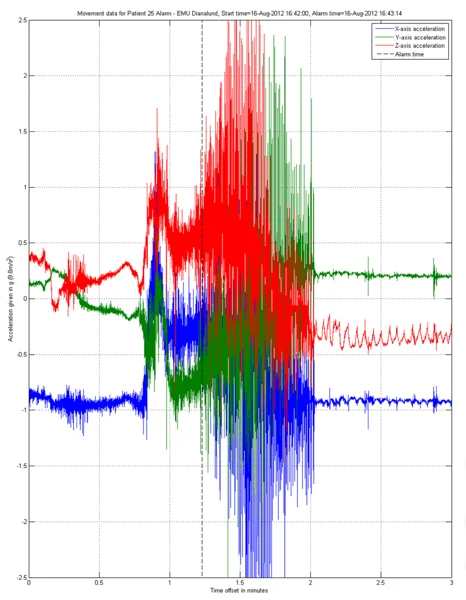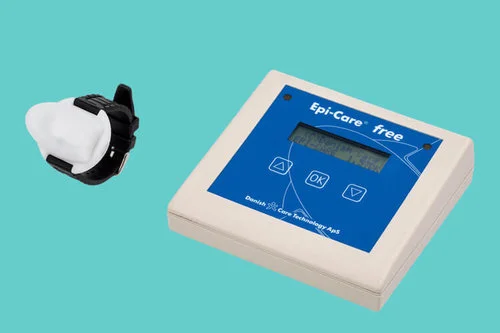David's story: Finding the right seizure alarm for my son with epilepsy
David wrote us an email to us asking for a manual for Epi-Care free.
When I replied, I asked David where he learned about the Epi-Care free, what problems he expected it to solve and his impressions.
David wrote a very comprehensive reply, telling about the consideration you have as a parent when choosing epilepsy detection.
We have asked for David's permission to share parts of his email on our blog, as we think it could be useful for others in a similar position.
- Jens Jørgen Eriksen. CEO of Danish Care Technology
... To give you some background as to why we chose the Epi-Care Free, it is necessary to first explain that our son, Simon, is autistic with learning difficulties and normally lives in a specialist care home but also has home visits for a few days each month, occasional longer stays such as at Christmas, and comes on holiday with us every year.
In the care home, his bed was fitted with a mat type sensor, but this did not provide any protection for when Simon was in his bedroom, say watching TV or if he got out of bed in the night. There was also a “baby monitor” type device in his room but Simon had suffered from 2 or 3 quite serious seizures. Including one, undetected by the monitors, where he fell and injured himself and had to go to the hospital. This was worrying for us and the staff at the care home.
We therefore wanted a solution that would reliably detect a seizure when Simon was unattended in his room (or elsewhere in the care home) and was portable enough for us to use at home or on holiday. It had to be reasonably robust and suitable for use in a care home environment – not too complicated to use. Simon never goes out unaccompanied, so we did not need a solution that would work outdoors. We did quite a lot of research and consulted with Simon’s epilepsy nurse and the care home team throughout.
There are some other wrist worn devices that we considered apart from the Epi-Care Free. However, they needed to link with a smartphone or iPad and we did not think that Simon would be able to cope with using such a device. We did consider asking the staff to look after the smartphone but thought that there were too many people involved and some might not be comfortable to use a smartphone in this way. We were also concerned about the range of the Bluetooth signal as Simon’s care home is quite large.
David built a spreadsheet
I built a spreadsheet which evaluated all the systems we considered and tested them against the following scenarios:
Scenario 1: Simon has a seizure at night whilst in bed
Scenario 2: Simon has a seizure during night whilst out of bed (for example if he went to bathroom or fell out of bed at onset of the seizure)
Scenario 3: Simon has a seizure when alone in the room but not in bed
Scenario 4: Simon has a seizure when alone, not in his own room but elsewhere in the house (range of signal)
Scenario 5: Seizure stops breathing / heart without convulsions or before convulsions trigger movement sensor (due to time delay feature to prevent false alarms)
Scenario 6: Seizure occurs when the device is not working such as during charging (not including smart device / App crash)
Scenario 6: Compatibility with sleeping carer
Scenario 7: False alarms during the night
Scenario 8: False alarms during the day
Scenario 9: Other potential failure modes (such as battery life, app crash, smart device issues, etc)
Scenario 10: Failure due to loss or breakage
Scenario 11: Loss of privacy issues affecting usability of device
The Epi-Care Free came out best overall and scored well in all scenarios apart from Scenario 5 where a pulse monitoring device came out well. The Epi-Care free also came out well as being suitable for (in order of importance) use in a care home, at home and on holiday.
Twelve reasons why David choose Epi-Care free
Ultimately, the Epi-Care Free (with Control Box, INKA transmitter and infopager2) came out as the best solution for Simon because of:
Range – we have tested it in Simon’s care home and he is always “in range” even when he is at the furthest corners of the house.
Reliability – published test data available so that we and the care home staff can have confidence that it will work when needed.
Simple to operate – The care home staff quickly learned the basic functions and it is designed to minimise the chance of errors.
The sensor only needs charging once per day and this takes less than an hour so it can be done when Simon is accompanied by a carer – they charge the pager at the same time.
Simon only has to learn to wear the sensor and remember to take it off when he goes out or takes a bath – he learned this very quickly and seems to find it comfortable – nothing to tamper with on the sensor.
Sensor seems robust and is splashproof – LED indicates “out of range” condition.
The control box is mains powered and the INKA (transmitter for the pager) has a long battery life so not too much routine maintenance is required.
The control box stores useful data about the date/time, intensity and duration of any seizures.
Portability – it is portable enough and only takes about 5 – 10 minutes to set up and test when it has been relocated.
No reliance on a smartphone (signal, Bluetooth, app, etc.) and no subscription required.
Service required only once every 2 years.
Pause function with automatic rearming is useful – Simon occasionally gets excited and flaps his arms causing false alarms.
Simon’s epilepsy nurse has taken a keen interest in the Epi-Care Free from the start and she is just as impressed with it as we are – there has been a lot of interest in it from her colleagues too. Above all, the Epi-Care Free has given us and the care home staff, peace of mind that we will be alerted whenever Simon has a seizure.
We think Danish Care Technology has developed an excellent system and would unreservedly recommend it to anyone with similar needs – if a “Mark 2” version is ever developed, it might be worth considering if a pulse monitoring device could also be added and increased water resistance to make it even better!
/David
Please let Jens Jørgen Eriksen know if you have any questions or comments to David's email. Contact us here
This is what a seizure looks like through the "eyes" of Epi-Care free's algorithm
Epi-Care free uses a triaxial accelerometer to detect the movements of the person wearing the sensor. The alarm relies on an algorithm to distinguish between normal movements and an epileptic seizure. The technology behind Epi-Care free is clinically tested. Read more about the test here:
Feedback or own user experience?
You also want to share your experiences with an Epi-Care device? Feel free to contact us - We appreciate any feedback, suggestions and testimonials!


